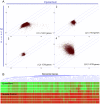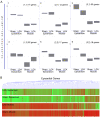Revealing new mouse epicardial cell markers through transcriptomics
- PMID: 20596535
- PMCID: PMC2893200
- DOI: 10.1371/journal.pone.0011429
Revealing new mouse epicardial cell markers through transcriptomics
Abstract
Background: The epicardium has key functions during myocardial development, by contributing to the formation of coronary endothelial and smooth muscle cells, cardiac fibroblasts, and potentially cardiomyocytes. The epicardium plays a morphogenetic role by emitting signals to promote and maintain cardiomyocyte proliferation. In a regenerative context, the adult epicardium might comprise a progenitor cell population that can be induced to contribute to cardiac repair. Although some genes involved in epicardial function have been identified, a detailed molecular profile of epicardial gene expression has not been available.
Methodology: Using laser capture microscopy, we isolated the epicardial layer from the adult murine heart before or after cardiac infarction in wildtype mice and mice expressing a transgenic IGF-1 propeptide (mIGF-1) that enhances cardiac repair, and analyzed the transcription profile using DNA microarrays.
Principal findings: Expression of epithelial genes such as basonuclin, dermokine, and glycoprotein M6A are highly enriched in the epicardial layer, which maintains expression of selected embryonic genes involved in epicardial development in mIGF-1 transgenic hearts. After myocardial infarct, a subset of differentially expressed genes are down-regulated in the epicardium representing an epicardium-specific signature that responds to injury.
Conclusion: This study presents the description of the murine epicardial transcriptome obtained from snap frozen tissues, providing essential information for further analysis of this important cardiac cell layer.
Conflict of interest statement
Figures




Similar articles
-
Regenerative potential of epicardium-derived extracellular vesicles mediated by conserved miRNA transfer.Cardiovasc Res. 2022 Jan 29;118(2):597-611. doi: 10.1093/cvr/cvab054. Cardiovasc Res. 2022. PMID: 33599250 Free PMC article.
-
C/EBP transcription factors mediate epicardial activation during heart development and injury.Science. 2012 Dec 21;338(6114):1599-603. doi: 10.1126/science.1229765. Epub 2012 Nov 15. Science. 2012. PMID: 23160954 Free PMC article.
-
Cardiac regeneration from activated epicardium.PLoS One. 2012;7(9):e44692. doi: 10.1371/journal.pone.0044692. Epub 2012 Sep 20. PLoS One. 2012. PMID: 23028582 Free PMC article.
-
Regulation of Epicardial Cell Fate during Cardiac Development and Disease: An Overview.Int J Mol Sci. 2022 Mar 16;23(6):3220. doi: 10.3390/ijms23063220. Int J Mol Sci. 2022. PMID: 35328640 Free PMC article. Review.
-
The arterial and cardiac epicardium in development, disease and repair.Differentiation. 2012 Jul;84(1):41-53. doi: 10.1016/j.diff.2012.05.002. Epub 2012 May 30. Differentiation. 2012. PMID: 22652098 Review.
Cited by
-
MACS Isolation and Culture of Mouse Liver Mesothelial Cells.Bio Protoc. 2015 Jul 5;3(13):e815. doi: 10.21769/bioprotoc.815. Bio Protoc. 2015. PMID: 27430003 Free PMC article.
-
Recapturing embryonic potential in the adult epicardium: Prospects for cardiac repair.Stem Cells Transl Med. 2021 Apr;10(4):511-521. doi: 10.1002/sctm.20-0352. Epub 2020 Nov 21. Stem Cells Transl Med. 2021. PMID: 33222384 Free PMC article. Review.
-
Cardiac regenerative therapy: Many paths to repair.Trends Cardiovasc Med. 2020 Aug;30(6):338-343. doi: 10.1016/j.tcm.2019.08.009. Epub 2019 Sep 2. Trends Cardiovasc Med. 2020. PMID: 31515053 Free PMC article. Review.
-
Pancreatic organogenesis mapped through space and time.Exp Mol Med. 2025 Feb;57(1):204-220. doi: 10.1038/s12276-024-01384-y. Epub 2025 Jan 8. Exp Mol Med. 2025. PMID: 39779976 Free PMC article.
-
CTGF-D4 Amplifies LRP6 Signaling to Promote Grafts of Adult Epicardial-derived Cells That Improve Cardiac Function After Myocardial Infarction.Stem Cells. 2022 Mar 16;40(2):204-214. doi: 10.1093/stmcls/sxab016. Stem Cells. 2022. PMID: 35257185 Free PMC article.
References
-
- Reese DE, Mikawa T, Bader DM. Development of the coronary vessel system. Circ Res. 2002;91:761–768. - PubMed
Publication types
MeSH terms
Substances
Grants and funding
LinkOut - more resources
Full Text Sources
Other Literature Sources
Miscellaneous

